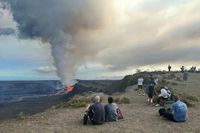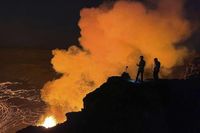As the sun sets over Hawaii’s Big Island, anticipation builds once more around the restless summit of Kilauea, one of the world’s most active volcanoes. Scientists are on high alert this week, expecting the 31st episode of lava eruption since December 2024—a dramatic milestone that underscores the volcano’s unyielding power and cultural significance.
For those lucky enough to be present at Hawaii Volcanoes National Park, the spectacle is nothing short of breathtaking. Lava fountains shoot skyward, sometimes soaring more than 1,000 feet (300 meters), painting the night sky in vivid reds and oranges. The molten rock currently erupts from two vents simultaneously at Halemaumau Crater, the site that Native Hawaiian tradition reveres as the home of the volcano goddess Pele. The rest of the world, meanwhile, tunes in via popular livestreams, courtesy of three camera angles set up by the U.S. Geological Survey (USGS), offering a virtual front-row seat to nature’s fiery performance.
“Every eruption feels like I am sitting in the front row at nature’s most extraordinary show,” said Janice Wei, a Park Service volunteer who races to the crater at every sign of renewed activity. She describes the eruption’s sound as a blend of a roaring jet engine and crashing ocean waves, and notes she can feel the heat from over a mile away. Her photos and videos have helped bring the drama of Kilauea to a global audience, even as she experiences its raw power up close.
Kilauea sits on Hawaii Island, the largest in the archipelago, about 200 miles (320 kilometers) south of Honolulu. Its current eruption pattern is the fourth such episode in the last 200 years, with similar sequences recorded in 1959, 1969, and a particularly long-lived eruption that began in 1983. That earlier event started with 44 separate lava fountain sessions over three years and ultimately continued in various forms until 2018, transforming parts of the island and captivating volcanologists worldwide.
At the heart of Kilauea’s activity is a dynamic system of magma chambers beneath Halemaumau Crater. According to Ken Hon, scientist-in-charge at the Hawaiian Volcanoes Observatory, a lower chamber is currently receiving magma from deep within the earth at a rate of about five cubic yards (3.8 cubic meters) per second. This influx inflates the chamber like a balloon, pushing magma into an upper chamber and eventually forcing it to the surface through cracks. The process is driven in part by gassy, pressurized magma traveling through narrow, pipe-like vents—a setup that can result in spectacular, champagne-cork-like bursts of lava when enough pressure builds.
“Our job is like being a bunch of ants crawling on an elephant trying to figure out how the elephant works,” Hon said, capturing both the complexity and humility involved in monitoring such an unpredictable force of nature. Scientists use a network of sensors to detect earthquakes and subtle shifts in ground angle, which can help them estimate, days or even a week in advance, when the next eruption might occur. Still, the volcano remains full of surprises, and no one can say for sure how this current sequence will end. In 1983, for instance, mounting pressure led Kilauea to open a new vent at a lower elevation, shifting from periodic fountains to a continuous, decades-long outpouring of lava.
Recently, the lava fountains have been somewhat shorter than in previous months. Steve Lundblad, a geology professor at the University of Hawaii at Hilo, suggests this may be due to a widening vent, which reduces pressure and changes the dynamics of the eruption. “We’re still gonna have spectacular eruptions,” Lundblad said. “They’re just going to be wider and not as high.”
For many residents, lava is far more than a geological hazard; it’s a vital natural resource and a cornerstone of cultural identity. Huihui Kanahele-Mossman, executive director of the Edith Kanakaʻole Foundation, sees each eruption as a living connection to the land and its stories. Her nonprofit, named after her grandmother—a revered practitioner of Hawaiian language and culture—helps keep alive the traditions rooted in the tales of Pele and her sister, Hiʻiaka. At the crater, Kanahele-Mossman delivers chants, offers awa (a kava-based drink), and weaves fern leis as tributes, echoing the centuries-old mele (songs) her school performs. “You as the dancer, you are the storyteller and you carry that history that was written in those mele forward,” she said. “To be able to actually see that eruption that’s described in the mele, that’s always exciting to us and drives us and motivates us to stay in this tradition.”
The ongoing eruptions have also sparked a surge in visitors to Hawaii Volcanoes National Park. According to park spokesperson Jessica Ferracane, visitation has risen every month so far this year, with April seeing a 49% increase compared to the same month in 2024. The allure of witnessing nature’s fury firsthand is strong, but Ferracane and other officials urge caution. Recent eruption episodes have lasted just 10 to 12 hours, so timing is everything for would-be spectators. The USGS offers alert notifications, and park staff recommend that visitors sign up to avoid missing the fleeting spectacle.
Safety, however, remains a top priority. Park rangers warn that unstable cliff edges, hidden earth cracks, and shifting terrain can pose serious risks—sometimes with little warning. Volcanic gases, fine glass particles, and ash can also be hazardous, especially for children and those with respiratory issues. For those visiting after dark, a flashlight is a must, and everyone is advised to stick to marked trails and overlooks.
Despite the dangers, the draw of Kilauea is undeniable. Hundreds of thousands of people from around the world are tuning in to the USGS livestreams, while a fortunate few experience the heat and roar of the volcano in person. For scientists, artists, and cultural practitioners alike, Kilauea is both a laboratory and a living legend—a place where the history of the land is written anew with every burst of molten rock.
The story of Kilauea’s latest eruptions is still being written, both by the scientists who study its patterns and by the communities who live in its shadow. As the volcano continues its cycle of destruction and creation, it remains a symbol of Hawaii’s enduring connection to the earth beneath its feet—and to the fiery forces that shape its future.





